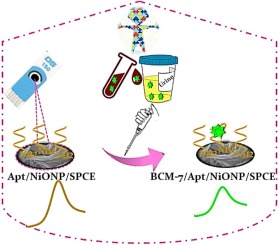当前位置:
X-MOL 学术
›
Colloids Surf. B Biointerfaces
›
论文详情
Our official English website, www.x-mol.net, welcomes your
feedback! (Note: you will need to create a separate account there.)
Architecting of a biodevice based on a screen-printed carbon electrode modified with the NiONP nanolayer and aptamer in BCM-7 detection.
Colloids and Surfaces B: Biointerfaces ( IF 5.4 ) Pub Date : 2020-03-03 , DOI: 10.1016/j.colsurfb.2020.110932 Faezeh Shahdost-Fard 1 , Mahmoud Roushani 1
Colloids and Surfaces B: Biointerfaces ( IF 5.4 ) Pub Date : 2020-03-03 , DOI: 10.1016/j.colsurfb.2020.110932 Faezeh Shahdost-Fard 1 , Mahmoud Roushani 1
Affiliation

|
In this study, an ultrasensitive and robust biodevice implemented on a screen-printed carbon electrode (SPCE) surface is introduced. The β-casomorphin-7 (BCM-7) peptide as an early warning sign of autism disorder is distinguished in this system. The SPCE surface was directly electrodeposited with a nanolayer of the nickel oxide nanoparticles (NiONP). In next step, an Apt sequence as a capture of the BCM-7 was strongly attached on this surface. The embedded sensing interface offered some admirable characterizes to detect the BCM-7. The obtained DPV signals were reversely proportional to the concentrations of the BCM-7 through a stable binding reaction in two working linear ranges from 0.5 × 10-9-1.5 μmol l-. Also, an unrivaled limit of detection (LOD) value of 166.6 aM was achieved that is so superior by other reported methods in the BCM-7 sensing. This hand-held biodevice was satisfactorily tested for the BCM-7 detection in human urine and blood sample with an average recovery rate of ∼101.87 %. More importantly, this strategy is free from labeling steps, complex sample processing and interference from common biomolecules in blood or urine. Due to the inherent advantages of the SPCE and the NiONP, utilizing this facile sensing interface may be an ideal choice in constructing of the ultrasensitive biodevice with low cost for distinguishing of the autism disorder.
中文翻译:

基于BCM-7检测中经NiONP纳米层和适体修饰的丝网印刷碳电极的生物设备的设计。
在这项研究中,介绍了一种在丝网印刷碳电极(SPCE)表面上实现的超灵敏耐用的生物设备。在该系统中,β-casomorphin-7(BCM-7)肽是自闭症的早期预警信号。SPCE表面直接电沉积有氧化镍纳米颗粒(NiONP)的纳米层。下一步,将捕获BCM-7的Apt序列牢固地附着在该表面上。嵌入式传感接口为检测BCM-7提供了令人钦佩的特性。通过稳定的结合反应,在0.5×10-9-1.5μmoll-的两个工作线性范围内,获得的DPV信号与BCM-7的浓度成反比。而且,达到了166.6 aM的无与伦比的检测极限(LOD)值,在BCM-7传感中,这是其他报告方法所无法比拟的。对该手持式生物设备进行了令人满意的测试,以检测人尿液和血液中的BCM-7,平均回收率约为101.87%。更重要的是,该策略没有标记步骤,复杂的样品处理过程以及血液或尿液中常见生物分子的干扰。由于SPCE和NiONP的固有优势,利用这种简便的传感界面可能是构建超灵敏生物装置的理想选择,而且成本低廉,可用于区分自闭症。
更新日期:2020-03-03
中文翻译:

基于BCM-7检测中经NiONP纳米层和适体修饰的丝网印刷碳电极的生物设备的设计。
在这项研究中,介绍了一种在丝网印刷碳电极(SPCE)表面上实现的超灵敏耐用的生物设备。在该系统中,β-casomorphin-7(BCM-7)肽是自闭症的早期预警信号。SPCE表面直接电沉积有氧化镍纳米颗粒(NiONP)的纳米层。下一步,将捕获BCM-7的Apt序列牢固地附着在该表面上。嵌入式传感接口为检测BCM-7提供了令人钦佩的特性。通过稳定的结合反应,在0.5×10-9-1.5μmoll-的两个工作线性范围内,获得的DPV信号与BCM-7的浓度成反比。而且,达到了166.6 aM的无与伦比的检测极限(LOD)值,在BCM-7传感中,这是其他报告方法所无法比拟的。对该手持式生物设备进行了令人满意的测试,以检测人尿液和血液中的BCM-7,平均回收率约为101.87%。更重要的是,该策略没有标记步骤,复杂的样品处理过程以及血液或尿液中常见生物分子的干扰。由于SPCE和NiONP的固有优势,利用这种简便的传感界面可能是构建超灵敏生物装置的理想选择,而且成本低廉,可用于区分自闭症。











































 京公网安备 11010802027423号
京公网安备 11010802027423号